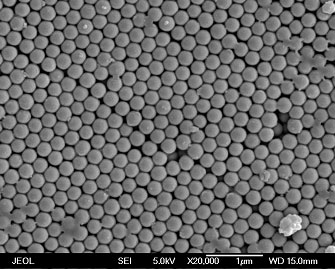What is Particle Science and Technology?
Particle Science and Technology is the study of particles. Here, we define a particle as a small discrete quantity of matter that has an interface with the surrounding environment. Most often particles are associated with solid materials that have an interface with an enveloping gas or liquid. However, particles might just as easily be liquid droplets in air, bubbles in water or emulsions. There is no rule governing how large or small an object must be to be considered a particle. Some define particles as ranging from one nanometer to one millimeter. Some place no size restriction at all - a heavenly body such as a planet or a star might be considered to be a very large particle. However, particle scientists generally leave the astronomical bodies and the molecular or sub-atomic particles to astronomers and physicists.
Particles - the oldest profession.
 Particle Technology is as old as mankind. Since the advent of agriculture, man has collected and winnowed grains, milled them into flour, brewed them into beverages and baked them into bread. Industrial uses of minerals date back to the stone and bronze ages where materials were used in particulate form to create ceramics and refine metals. The middle ages saw the advent of the pharmaceutical industry where the apothecary ground and various concoctions to cure disease. As with other technologies, the industrial revolution spawned an explosion of particle related advances from advanced mining techniques to abrasives, cutting tools, and mass production of chemicals and agricultural products. Modern scientific advances in paints and coatings were based in large part on the ability to control the dispersion and behavior of pigments and other particles in various base solvents. Composite materials appeared, coinciding with the rise in the polymer and plastic industries, industries that themselves rely heavily on particulate catalysts. Today, particle technology is on the verge of a new resurgence as the potential of nanotechnology is beginning to be realized. The design and manipulation of matter on the nanoscale by its very nature involves ultrafine particles or surfaces that have many of the same attributes as particulate systems.
Particle Technology is as old as mankind. Since the advent of agriculture, man has collected and winnowed grains, milled them into flour, brewed them into beverages and baked them into bread. Industrial uses of minerals date back to the stone and bronze ages where materials were used in particulate form to create ceramics and refine metals. The middle ages saw the advent of the pharmaceutical industry where the apothecary ground and various concoctions to cure disease. As with other technologies, the industrial revolution spawned an explosion of particle related advances from advanced mining techniques to abrasives, cutting tools, and mass production of chemicals and agricultural products. Modern scientific advances in paints and coatings were based in large part on the ability to control the dispersion and behavior of pigments and other particles in various base solvents. Composite materials appeared, coinciding with the rise in the polymer and plastic industries, industries that themselves rely heavily on particulate catalysts. Today, particle technology is on the verge of a new resurgence as the potential of nanotechnology is beginning to be realized. The design and manipulation of matter on the nanoscale by its very nature involves ultrafine particles or surfaces that have many of the same attributes as particulate systems.  Properties of materials are manipulated at the nanoscale and particles are self-assembled into nanostructures to give us photonic crystals, nanoscale catalysts, superhydrophobic surfaces, smart dust and even nanoscale "machines". Particles are making particular advances in the area of human healthcare where they are being used to diagnose illnesses, cure cancer, deliver drugs and retard aging. Particle Science is becoming recognized as an enabling technology that helps us create new energy sources, clean our air and water and build stronger and lighter materials. Particle Technology is not at the end of its development, its potential has just begun!
Properties of materials are manipulated at the nanoscale and particles are self-assembled into nanostructures to give us photonic crystals, nanoscale catalysts, superhydrophobic surfaces, smart dust and even nanoscale "machines". Particles are making particular advances in the area of human healthcare where they are being used to diagnose illnesses, cure cancer, deliver drugs and retard aging. Particle Science is becoming recognized as an enabling technology that helps us create new energy sources, clean our air and water and build stronger and lighter materials. Particle Technology is not at the end of its development, its potential has just begun!
The Impact of Particle Technology
The significance of particle technologies often goes unnoticed in our society. Water purification, waste treatment, clean air, food preservation, and a vast number of industrial products have all resulted from a quite sophisticated understanding of particle technology. For example, clean drinking water requires filtration through particle beds, administering chemicals, and post treatment with a variety of adsorbents such as activated carbon. Ever more sophisticated applications of particle technology are on the horizon. For, example carbon nanotubes are very unique particles with a structure that resembles graphene. Depending on the method of manufacture, they can have a strength hundreds of times that of steel, an electrical conductivity a thousand times that of silver or they can be insulators and semi-conductors. If particle scientists can control these properties, aircraft and vehicles will be lighter, fuels will be more efficient, computers will be smaller and faster, power requirements lower along with many other applications yet to be conceived. All of these applications, however, are dependent on being able to control the structure and behavior of these nanoparticles.
The neglect of particle science has caused major challenges to society, especially in the areas of agriculture (famine) and the environment (air and water pollution). Opportunities lost are difficult to quantify but as we begin to see the current potential of particles in the areas of nanotechnology, one can imagine where we might be if our best and our brightest would select this field of endeavor.
The Modern Particle Scientist
Particle Engineers are by their nature scientific eclectics. No one scientific discipline can claim the particle technologist as its own. An understanding of physics, chemistry, materials engineering, mechanical and many other disciplines is necessary to understand and control the behavior of particle systems. Consequently, the field is very interdisciplinary with scientists of all types working together to solve complex problems. For example, tiny gold nanoparticles decorated with biological molecules may hold the key to curing some cancers. Particle scientists, chemists, physicists, molecular biologists, physicians, chemical engineers and scientists from other disciplines all work together to design such therapies in what is a very complex physiological environment. An environment that itself consists of "biological" particles such as cells, proteins along with a myriad of structures that circulate in the bloodstream or self-assemble into tissues and organs. These biological particles have all of the same properties as their abiotic cousins including physical behavior, surface chemistry, transport phenomena, etc. yet with increase in complexity that will challenge the next generation of particle "biologists".
Training in Particle Technology is one of the most valuable commodities in the job market today for a variety of reasons. Professionals trained in Particle Science are forced to develop an understanding of fundamental sciences such as chemistry and physics along with an increased appreciation for the engineering sciences. By its nature, particle technology is interdisciplinary forcing students to think outside their comfort zones - outside the proverbial box. Virtually all industries are available to the student trained in particle science - microelectronics, chemical, consumer products, mining, environmental, construction, agriculture etc. All have issues involving particulate materials and all have the need for bright young scientists that can apply sound scientific principles to their problems. Many of society's major challenges are particle related including air and water quality in our environment, dwindling natural resources, agricultural efficiency, energy independence and world-wide sustainability practices.
The Future of Particles
Nor is the importance of particle technology limited to our planet. Nano sized particles make up photocatalysts that may be the key to water recycling on extended space missions. Moon dust and Mars dust present significant hazards to explorers and have to be controlled to prevent fouling of optical components, failure of mechanical components and to preserve the health and hygiene of the astronauts themselves. The behavior of particles under vacuum or at zero or reduced g-forces has yet to be fully explored. With new rules, there is a whole spectrum of properties to be considered for particles in space. Just as there are new worlds to explore in our solar system, so too, there are new worlds to explore in the tiniest bits of matter, particles!